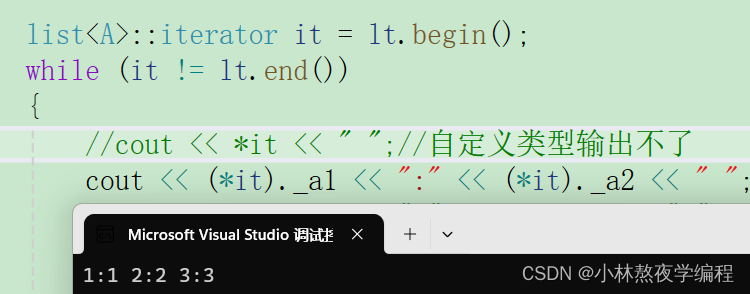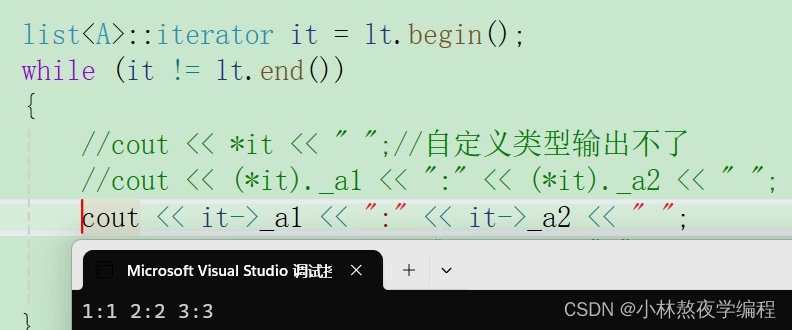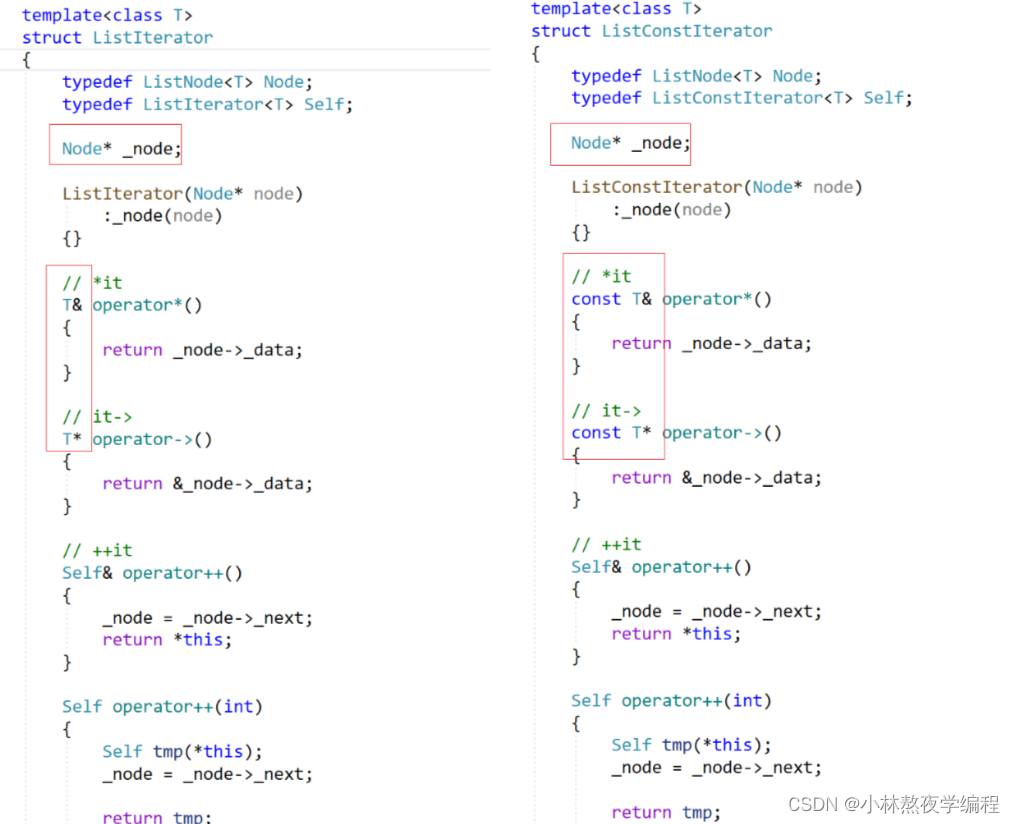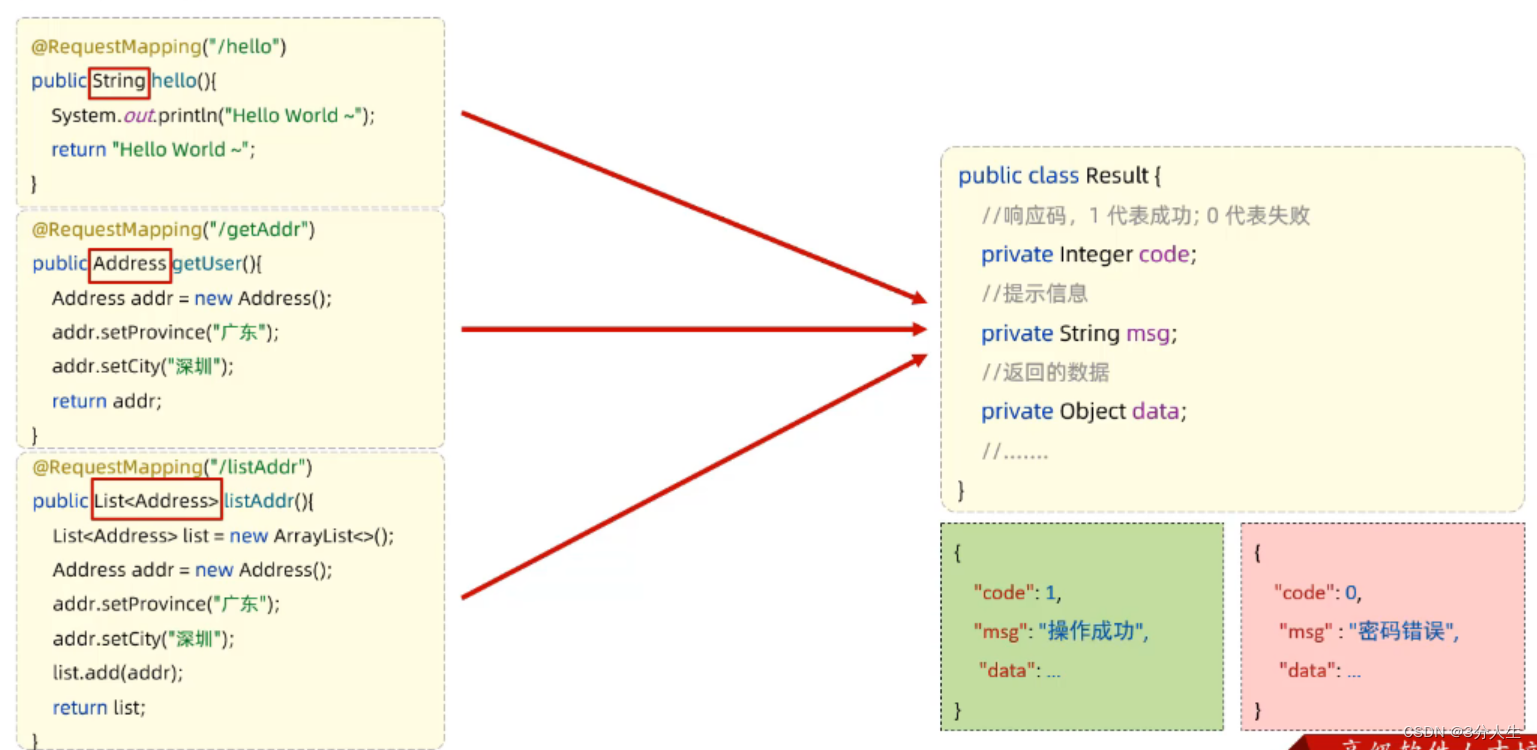
✨个人主页: 熬夜学编程的小林
💗系列专栏: 【C语言详解】 【数据结构详解】【C++详解】
目录
1、函数补充
2、迭代器完善
3、const迭代器
总结
1、函数补充
拷贝构造
思路:
- 先构造一个头结点,然后将 lt 类中的元素依次尾插到新的结点上。
void empty_init()
{_head = new Node;_head->_next = _head;_head->_prev = _head;_size = 0;
}
list(const list<T>& lt)
{empty_init();//构造一个头结点for (auto& x : lt){push_back(x);}
}{}初始化构造
思路:
- 先构造一个头结点,然后将 il 类中的元素依次尾插到新的结点上。
list(initializer_list<T> il)
{empty_init();for (auto& x : il){push_back(x);}
}赋值操作符重载
void swap(list<T>& lt)
{std::swap(_head, lt._head);std::swap(_size, lt._size);
}
list<T>& operator=(list<T> lt)
{swap(lt);return *this;
}大小相关函数
size_t size()
{return _size;
}
bool empty()
{return _size == 0;
}clear()
清空list的内容,保留头结点。
//清空数据
void clear()
{iterator it = begin();while (it != end()){it = erase(it);//更新迭代器}
}~list()
析构函数,清空list的内容并释放头结点。
~list()
{clear();//清空内容函数delete _head;//释放头结点_head = nullptr;//置空
}2、迭代器完善
前面我们处理的都是内置类型的情况,如果我们出现自定义类型,如何解决?
自定义类型举例:
struct A
{int _a1;int _a2;A(int a1 = 0, int a2 = 0):_a1(a1), _a2(a2){}
};首先我们先看看几种自定义类型的尾插方式:
void test_list3()
{list<A> lt;A aa1(1, 1);//实例化对象A aa2{ 2,2 };//多参数的隐式类型转换,C++11lt.push_back(aa1);//有名对象实例化lt.push_back(aa2);lt.push_back(A(3, 3));//匿名对象lt.push_back({ 4,4 });//多参数的隐式类型转换,C++11
}对自定义类型进行遍历:
list<A>::iterator it = lt.begin();
while (it != lt.end())
{cout << *it << " ";//自定义类型输出不了it++;
}
cout << endl;
A是自定义类型,不支持留插入,我们解引用得到的_data是A的对象 。在结构体中我们获取到自定义类型的对象可以通过 . 进行访问内部成员,此处我们也可以使用 . 进行访问内部成员。
cout << (*it)._a1 << ":" << (*it)._a2 << " ";
但是如果这么使用会有一点别捏,我们在自定义类型中,也可以通过自定义类型的地址来访问成员,即通过 ->访问,此处我们也可以通过 ->进行访问,因此我们需要重载一个operator->()函数 。
迭代器类中重载operator->
T* operator->()
{return &_node->_data;//取数据的地址
}使用->访问元素
cout << it->_a1 << ":" << it->_a2 << " ";使用重载函数版
cout << it.operator->()->_a1 << ":" << it.operator->()->_a2 << " ";测试结果:

注意:
这里隐藏了一个箭头,一个是重载,一个是原生指针的访问操作。
当重载 operator->,不会直接返回成员的值,而是应该返回一个指针,这个指针指向的对象包含我们想要访问的成员。当使用
->运算符时,C++ 会自动和透明地调用重载的operator->并继续 “链式” 访问成员,而不需要程序员显示地添加多余的箭头。
3、const迭代器
我们上一弹写的普通迭代器对于const对象是无法编译成功的,const不能调用非const成员函数(权限放大)。
下面我们则实现一个const迭代器的类。
与普通迭代器类似,我们需要先在list类中重命名一个const迭代器
typedef ListConstIterator<T> const_iterator;//const迭代器类const_iterator begin() const
{return const_iterator(_head->_next);//匿名对象//return _head->_next;//单参数类型转换
}
const_iterator end() const
{return const_iterator(_head);
}注意:
const迭代器名字不能写成 const iterator,因为const迭代器的本质是迭代器指向的内容不能修改,而不是迭代器本身不能修改,const_iterator这样定义是迭代器不能修改,内容还是可以修改的
实现const_iterator类有两种方式,如下:
方式一(单独实现一个新的类,修改普通迭代器的部分地方):
template<class T>
struct ListConstIterator
{typedef ListConstIterator<T> Self;//对迭代器类重定义typedef ListNode<T> Node;Node* _node;//构造ListConstIterator(Node* node):_node(node){}const T& operator*()//只能访问,不能修改值{return _node->_data;}const T* operator->(){return &_node->_data;//返回指针}//前置++ Self& operator++(){_node = _node->_next;return *this;}//后置++Self operator++(int){Self tmp(*this);_node = _node->_next;return *this;}Self& operator--(){_node = _node->_prev;return *this;}Self operator--(int){Self tmp(*this);_node = _node->_prev;return tmp;}bool operator!=(const Self& it){return _node != it._node;}bool operator==(const Self& it){return _node == it._node;}
};
我们可以看到,const迭代器与普通迭代器的区间只在operator*与operator->的返回的类型上,那么我们是不是可以将两个类封装成一个模板类呢???
//普通迭代器和const迭代器只有两个返回值不同,因此我们使用模板封装
template<class T, class Ref, class Ptr>//reference引用 point指针
struct ListIterator
{typedef ListIterator<T, Ref, Ptr> Self;//对迭代器类重定义typedef ListNode<T> Node;Node* _node;//构造ListIterator(Node* node):_node(node){}//T& operator*()//遍历及修改Ref operator*(){return _node->_data;}//T* operator->()Ptr operator->(){return &_node->_data;//返回指针}//前置++ Self& operator++(){_node = _node->_next;return *this;}//后置++Self operator++(int){Self tmp(*this);_node = _node->_next;return tmp;//返回临时变量}//前置--Self& operator--(){_node = _node->_prev;return *this;}//后置--Self operator--(int){Self tmp(*this);_node = _node->_prev;return tmp;//返回临时变量}bool operator!=(const Self& it){return _node != it._node;}bool operator==(const Self& it){return _node == it._node;}
};合并之后的三个类模板参数:
T:链表结点存储_data值的数据类型Ref:通过迭代器访问数据时的返回类型,可以是T&或者const T&。Ptr:通过迭代器访问数据的指针类型,可以是T*或者const T*。
链表实例化如下:
typedef ListIterator<T, T&, T*> iterator;//普通迭代器类typedef ListIterator<T, const T&, const T*> const_iterator;//const迭代器类list实现全部代码
namespace lin
{//链表基本结构template<class T>struct ListNode{ListNode<T>* _prev;ListNode<T>* _next;T _data;ListNode(const T& val = T())//初始化值构造:_prev(nullptr),_next(nullptr),_data(val){}};//原版普通迭代器//迭代器操作类 方法都要被访问,使用struct//template<class T>//struct ListIterator//{// typedef ListIterator<T> Self;//对迭代器类重定义// typedef ListNode<T> Node;// Node* _node;// //构造// ListIterator(Node* node)// :_node(node)// {}// T& operator*()//遍历及修改// {// return _node->_data;// }// T* operator->()// {// return &_node->_data;//返回指针// }// //前置++ // Self& operator++()// {// _node = _node->_next;// return *this;// }// //后置++// Self operator++(int)// {// Self tmp(*this);// _node = _node->_next;// return *this;// }// bool operator!=(const Self& it)// {// return _node != it._node;// }// bool operator==(const Self& it)// {// return _node == it._node;// }//};//原版const迭代器//template<class T>//struct ListConstIterator//{// typedef ListConstIterator<T> Self;//对迭代器类重定义// typedef ListNode<T> Node;// Node* _node;// //构造// ListConstIterator(Node* node)// :_node(node)// {}// const T& operator*()//只能访问,不能修改值// {// return _node->_data;// }// const T* operator->()// {// return &_node->_data;//返回指针// }// //前置++ // Self& operator++()// {// _node = _node->_next;// return *this;// }// //后置++// Self operator++(int)// {// Self tmp(*this);// _node = _node->_next;// return *this;// }// Self& operator--()// {// _node = _node->_prev;// return *this;// }// Self operator--(int)// {// Self tmp(*this);// _node = _node->_prev;// return tmp;// }// bool operator!=(const Self& it)// {// return _node != it._node;// }// bool operator==(const Self& it)// {// return _node == it._node;// }//};//普通迭代器和const迭代器只有两个返回值不同,因此我们使用模板封装template<class T, class Ref, class Ptr>//reference引用 point指针struct ListIterator{typedef ListIterator<T,Ref,Ptr> Self;//对迭代器类重定义typedef ListNode<T> Node;Node* _node;//构造ListIterator(Node* node):_node(node){}//T& operator*()//遍历及修改Ref operator*(){return _node->_data;}//T* operator->()Ptr operator->(){return &_node->_data;//返回指针}//前置++ Self& operator++(){_node = _node->_next;return *this;}//后置++Self operator++(int){Self tmp(*this);_node = _node->_next;return tmp;//返回临时变量}//前置--Self& operator--(){_node = _node->_prev;return *this;}//后置--Self operator--(int){Self tmp(*this);_node = _node->_prev;return tmp;//返回临时变量}bool operator!=(const Self& it){return _node != it._node;}bool operator==(const Self& it){return _node == it._node;}};template<class T>class list{typedef ListNode<T> Node;//将链表结构重命名public://普通版本//typedef ListIterator<T> iterator;//需要被访问,放在public内//typedef ListConstIterator<T> const_iterator;//const迭代器类//类模板typedef ListIterator<T,T&,T*> iterator;//需要被访问,放在public内typedef ListIterator<T,const T&,const T*> const_iterator;//const迭代器类//构造哨兵结点void empty_init(){_head = new Node;_head->_next = _head;_head->_prev = _head;}list()//默认构造{empty_init();//创建哨兵头结点}size_t size(){return _size;}void clear()//清空数据,不销毁哨兵头结点{iterator it = begin();while (it != end()){it = erase(it);}}~list()//析构函数{clear();delete _head;_head = nullptr;}list(const list<T>& lt)//拷贝构造{empty_init();//创建头结点,然后进行尾插for (auto& x : lt){push_back(x);}}void swap(list<T>& lt){std::swap(_head, lt._head);std::swap(_size, lt._size);}list<T>& operator=(list<T> lt){swap(lt);return *this;}iterator begin() {return iterator(_head->_next);//匿名对象//return _head->_next;//单参数类型转换}iterator end() {return iterator(_head);}//解决打印修改值问题const_iterator begin() const{return const_iterator(_head->_next);//匿名对象//return _head->_next;//单参数类型转换}const_iterator end() const{return const_iterator(_head);}//单独实现的尾插//void push_back(const T& val)//{// //tail // Node* newnode = new Node(val);// Node* tail = _head->_prev;// tail->_next = newnode;// newnode->_prev = tail;// newnode->_next = _head;// _head->_prev = newnode;//}void insert(iterator pos, const T& val)//在pos位置前插入val{Node* cur = pos._node;Node* newnode = new Node(val);Node* prev = cur->_prev;//prev newnode curnewnode->_next = cur;cur->_prev = newnode;prev->_next = newnode;newnode->_prev = prev;_size++;}iterator erase(iterator pos)//删除pos位置,防止迭代器失效,返回迭代器后一个位置{Node* cur = pos._node;Node* prev = cur->_prev;Node* next = cur->_next;//prev nextprev->_next = next;next->_prev = prev;delete cur;_size--;return iterator(next);}//调用insert函数void push_back(const T& val){//insert(--begin(),val);//不能使用+n,在--begin前面插入insert(end(), val);//end()前面}void push_front(const T& val){insert(begin(), val);//begin()前面插入}void pop_back(){erase(--end());//end()前面删除}void pop_front(){erase(begin());//begin()位置删除}private:Node* _head;//链表成员变量size_t _size;//链表大小};
}总结
本篇博客就结束啦,谢谢大家的观看,如果公主少年们有好的建议可以留言喔,谢谢大家啦!





